The Electric Facial Cleansing Brush Market is estimated to be valued at USD 9.9 billion in 2025 and is projected to reach USD 16.4 billion by 2035, registering a compound annual growth rate (CAGR) of 5.2% over the forecast period.
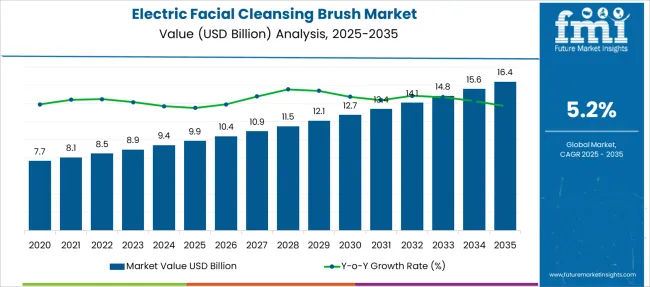
| Metric | Value |
|---|---|
| Electric Facial Cleansing Brush Market Estimated Value in (2025 E) | USD 9.9 billion |
| Electric Facial Cleansing Brush Market Forecast Value in (2035 F) | USD 16.4 billion |
| Forecast CAGR (2025 to 2035) | 5.2% |
The electric facial cleansing brush market is expanding rapidly due to growing consumer interest in advanced skincare tools that offer deeper cleansing and enhanced skin health. The rising awareness of personal grooming and self-care routines has encouraged the adoption of devices designed to improve skin texture and appearance.
Technological advancements have introduced more user-friendly, effective, and hygienic cleansing solutions that appeal to a wide range of consumers. Additionally, the surge in online beauty influencers and skincare education has increased product visibility and acceptance.
The household segment dominates usage, supported by rising disposable incomes and an expanding base of skincare enthusiasts. Future growth is expected as brands continue innovating with materials and technologies, responding to demands for gentle yet effective cleansing suitable for diverse skin types. Segmental growth is being driven by silicone product types, fixed technology devices, and household applications, reflecting consumer preferences for convenience, hygiene, and efficacy.
The market is segmented by Product Type, Technology, Application, and Price Range and region. By Product Type, the market is divided into Silicone, Plastic, and Bristle. In terms of Technology, the market is classified into Fixed, Rotating, and Oscillating. Based on Application, the market is segmented into Households and Commercial. By Price Range, the market is divided into Economy, Mid-Range, and Premium. Regionally, the market is classified into North America, Latin America, Western Europe, Eastern Europe, Balkan & Baltic Countries, Russia & Belarus, Central Asia, East Asia, South Asia & Pacific, and the Middle East & Africa.
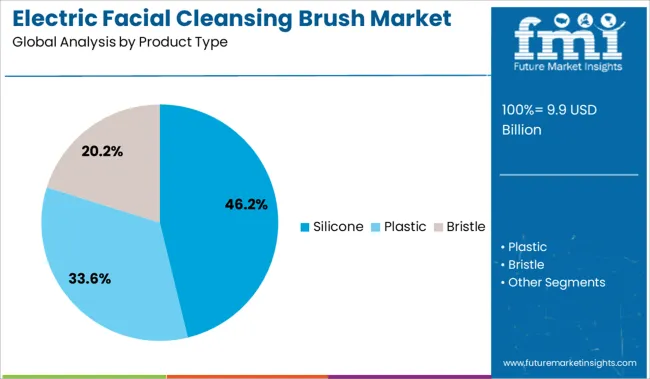
The Silicone product segment is projected to contribute 46.2% of the electric facial cleansing brush market revenue in 2025, securing its leading position. This growth has been driven by the material’s hypoallergenic and antibacterial properties, making it ideal for sensitive skin and daily use.
Consumers appreciate silicone brushes for their softness and durability compared to traditional bristle brushes, which can harbor bacteria and cause irritation. Additionally, silicone’s water resistance and ease of cleaning enhance device hygiene and longevity.
The material's adaptability has allowed manufacturers to design ergonomic and appealing devices that improve user experience. As awareness of skin health increases, the preference for silicone brushes is expected to rise due to their gentle yet effective cleansing performance.
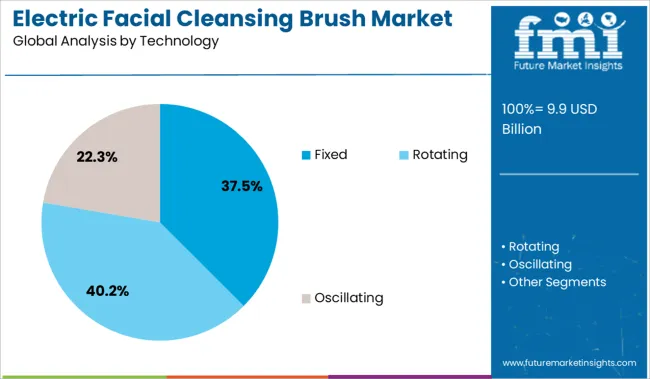
The Fixed technology segment is expected to account for 37.5% of the market revenue in 2025, maintaining its position as the dominant technology type. Fixed brush heads offer convenience and reliability by eliminating the need for replacement parts, which appeals to users seeking low-maintenance devices.
These models are often designed for long-term durability and consistent performance, providing steady cleansing without the hassle of changing brush heads. Additionally, fixed technology devices are typically more affordable and easier to operate, attracting a wide consumer base.
The segment has benefited from continuous product enhancements that optimize vibration frequencies and cleansing efficiency. As consumers prioritize ease of use and value, fixed technology brushes are likely to retain their market lead.
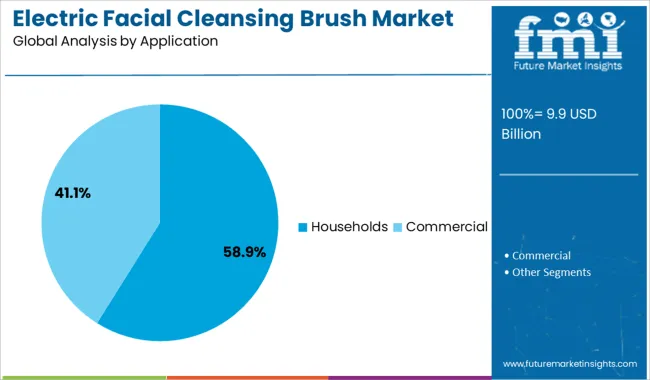
The Households segment is projected to represent 58.9% of the electric facial cleansing brush market revenue in 2025, dominating end-use applications. This growth has been fueled by increasing adoption of personal skincare devices for home use, driven by rising disposable incomes and growing interest in self-care routines.
Consumers are investing in at-home beauty tools that offer spa-like cleansing experiences, reducing the need for professional treatments. The convenience of these devices aligns with busy lifestyles and a preference for personalized skincare solutions.
Moreover, awareness campaigns and digital marketing have expanded the reach of electric facial cleansing brushes to diverse household demographics. As skincare remains a priority for consumers worldwide, household applications are expected to continue driving demand in this market.
The growing demand for electric facial cleansing brushes can be witnessed across the world. Increasing demand has engaged more manufacturers across the world in manufacturing electric facial cleansing brushes.
Key manufacturers in the market have focused on developing regions to penetrate due to increasing brand loyalty among consumers. However, the presence of unbranded products in the market may hamper the growth in demand for electric facial cleansing brushes during the forecast period.
Manufacturers of electric facial cleansing brushes are continuously investing in their Research and Development to come up with new features or products frequently. Increasing use of the dual motion technology in electric facial cleansing brushes that make skin soft is one of the factors expected to boost the market.
Competition is intense in the market as more companies are expressing interest in the electric facial cleansing brush market, increasing the sales of electric facial cleansing brushes.
Manufacturers are coming up with the latest technologies for electric facial cleansing brushes. Barrier care technology, and Hydro Boost cleanser are a few of the technologies that are generally used by manufacturers for producing electric facial cleansing brushes.
The electric facial cleansing brush market is expected to register healthy growth across all geographies during the forecast period. Individual use of electric facial cleansing brushes is higher than commercial use, which is growing across the globe and is likely to drive the sales of electric facial cleansing brushes in the market. Emerging countries, such as China, India, and Brazil, are the key markets with immense opportunities for the electric facial cleansing brush market.
A large number of populations, the growing popularity of skincare devices, changing lifestyles, and rising demand to look attractive boost the electric facial cleansing brush market.
The USA is the market dominator of the electric facial cleansing brush market due to better technology infrastructure, the high adoption rate of new launches, and the major market presence of manufacturers. Additionally, Middle East & Africa is projected to showcase steady growth in the sales of electric facial cleansing brush due to the growing demand for skincare & beauty products.
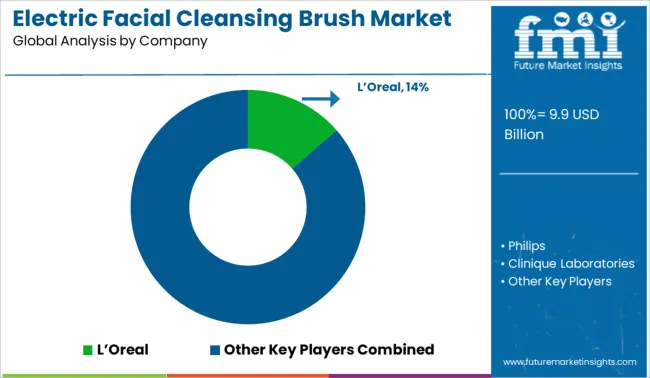
The key players in the Electric facial cleansing brush market are focusing on the efficiency, effectiveness, and skin-specific properties of these products. This drives the sales of hair lighting products.
Key players in the hair lighting products market include Clinique, Panasonic, Clarisonic Mia, Foreo, Proactiv, Olay, Neutrogena, pixnore, Michael Todd, Lavo Skin, Phillips, and Conair
Recent Market Development:
| Report Attribute | Details |
|---|---|
| Growth Rate | CAGR of 5.2% from 2025 to 2035 |
| The base year for estimation | 2024 |
| Historical data | 2020 to 2024 |
| Forecast period | 2025 to 2035 |
| Quantitative units | Revenue in USD billion, volume in kilotons, and CAGR from 2025 to 2035 |
| Report Coverage | Revenue forecast, volume forecast, company ranking, competitive landscape, growth factors, and trends, Pricing Analysis |
| Segments Covered | Technology, Price Range, Application, Sales Channel, Region |
| Regional scope | North America; Western Europe; Eastern Europe; Middle East; Africa; ASEAN; South Asia; Rest of Asia; Australia; and New Zealand |
| Country scope | USA, Canada, Mexico, Germany, United Kingdom, France, Italy, Spain, Russia, Belgium, Poland, Czech Republic, China, India, Japan, Australia, Brazil, Argentina, Colombia, Saudi Arabia, United Arab Emirates(UAE), Iran, South Africa |
| Key companies profiled | Clinique; Panasonic; Clarisonic Mia; Foreo; Proactiv; Olay; Neutrogena; pixnore; Michael Todd; Lavo Skin; Phillips; Conair |
| Customization scope | Free report customization (equivalent to up to 8 analysts' working days) with purchase. Addition or alteration to country, regional & segment scope. |
| Pricing and purchase options | Avail customized purchase options to meet your exact research needs. |
The global electric facial cleansing brush market is estimated to be valued at USD 9.9 billion in 2025.
The market size for the electric facial cleansing brush market is projected to reach USD 16.4 billion by 2035.
The electric facial cleansing brush market is expected to grow at a 5.2% CAGR between 2025 and 2035.
The key product types in electric facial cleansing brush market are silicone, plastic and bristle.
In terms of technology, fixed segment to command 37.5% share in the electric facial cleansing brush market in 2025.






Our Research Products

The "Full Research Suite" delivers actionable market intel, deep dives on markets or technologies, so clients act faster, cut risk, and unlock growth.

The Leaderboard benchmarks and ranks top vendors, classifying them as Established Leaders, Leading Challengers, or Disruptors & Challengers.

Locates where complements amplify value and substitutes erode it, forecasting net impact by horizon

We deliver granular, decision-grade intel: market sizing, 5-year forecasts, pricing, adoption, usage, revenue, and operational KPIs—plus competitor tracking, regulation, and value chains—across 60 countries broadly.

Spot the shifts before they hit your P&L. We track inflection points, adoption curves, pricing moves, and ecosystem plays to show where demand is heading, why it is changing, and what to do next across high-growth markets and disruptive tech

Real-time reads of user behavior. We track shifting priorities, perceptions of today’s and next-gen services, and provider experience, then pace how fast tech moves from trial to adoption, blending buyer, consumer, and channel inputs with social signals (#WhySwitch, #UX).

Partner with our analyst team to build a custom report designed around your business priorities. From analysing market trends to assessing competitors or crafting bespoke datasets, we tailor insights to your needs.
Supplier Intelligence
Discovery & Profiling
Capacity & Footprint
Performance & Risk
Compliance & Governance
Commercial Readiness
Who Supplies Whom
Scorecards & Shortlists
Playbooks & Docs
Category Intelligence
Definition & Scope
Demand & Use Cases
Cost Drivers
Market Structure
Supply Chain Map
Trade & Policy
Operating Norms
Deliverables
Buyer Intelligence
Account Basics
Spend & Scope
Procurement Model
Vendor Requirements
Terms & Policies
Entry Strategy
Pain Points & Triggers
Outputs
Pricing Analysis
Benchmarks
Trends
Should-Cost
Indexation
Landed Cost
Commercial Terms
Deliverables
Brand Analysis
Positioning & Value Prop
Share & Presence
Customer Evidence
Go-to-Market
Digital & Reputation
Compliance & Trust
KPIs & Gaps
Outputs
Full Research Suite comprises of:
Market outlook & trends analysis
Interviews & case studies
Strategic recommendations
Vendor profiles & capabilities analysis
5-year forecasts
8 regions and 60+ country-level data splits
Market segment data splits
12 months of continuous data updates
DELIVERED AS:
PDF EXCEL ONLINE
Electric Aircraft Onboard Sensors Market Size and Share Forecast Outlook 2025 to 2035
Electrical Label Market Size and Share Forecast Outlook 2025 to 2035
Electric Round Sprinklers Market Size and Share Forecast Outlook 2025 to 2035
Electric Cloth Cutting Scissors Market Size and Share Forecast Outlook 2025 to 2035
Electrical Insulation Materials Market Size and Share Forecast Outlook 2025 to 2035
Electric Aircraft Sensors Market Size and Share Forecast Outlook 2025 to 2035
Electric Traction Motor Market Forecast Outlook 2025 to 2035
Electric Vehicle Sensor Market Forecast and Outlook 2025 to 2035
Electric Vehicle Motor Market Forecast and Outlook 2025 to 2035
Electric Off-Road ATVs & UTVs Market Size and Share Forecast Outlook 2025 to 2035
Electric Blind Rivet Gun Market Size and Share Forecast Outlook 2025 to 2035
Electric Fireplace Market Size and Share Forecast Outlook 2025 to 2035
Electric Glider Market Size and Share Forecast Outlook 2025 to 2035
Electric Vehicle Battery Conditioners Market Size and Share Forecast Outlook 2025 to 2035
Electric Power Steering Motors Market Size and Share Forecast Outlook 2025 to 2035
Electric Motor Market Size and Share Forecast Outlook 2025 to 2035
Electric Gripper Market Size and Share Forecast Outlook 2025 to 2035
Electric Boat Market Size and Share Forecast Outlook 2025 to 2035
Electric Bicycle Market Size and Share Forecast Outlook 2025 to 2035
Electric Vehicle Transmission Market Size and Share Forecast Outlook 2025 to 2035

Thank you!
You will receive an email from our Business Development Manager. Please be sure to check your SPAM/JUNK folder too.
Chat With
MaRIA